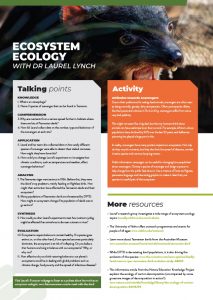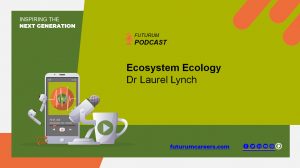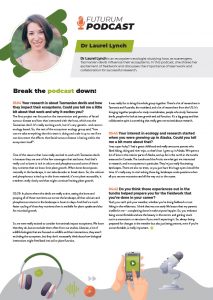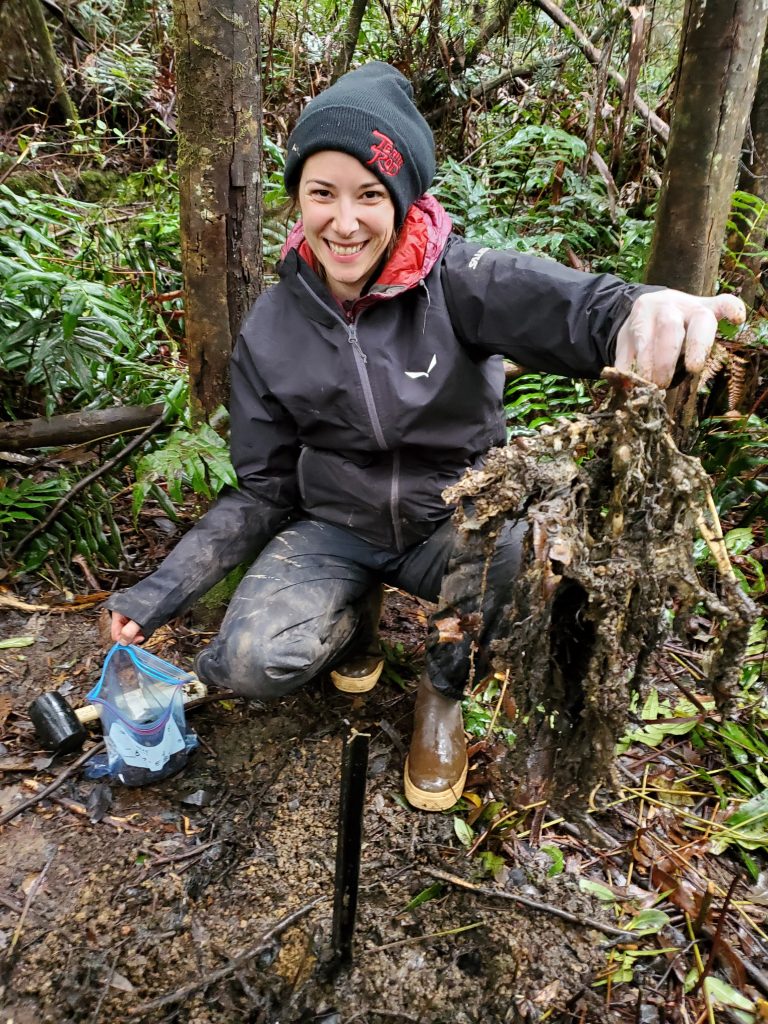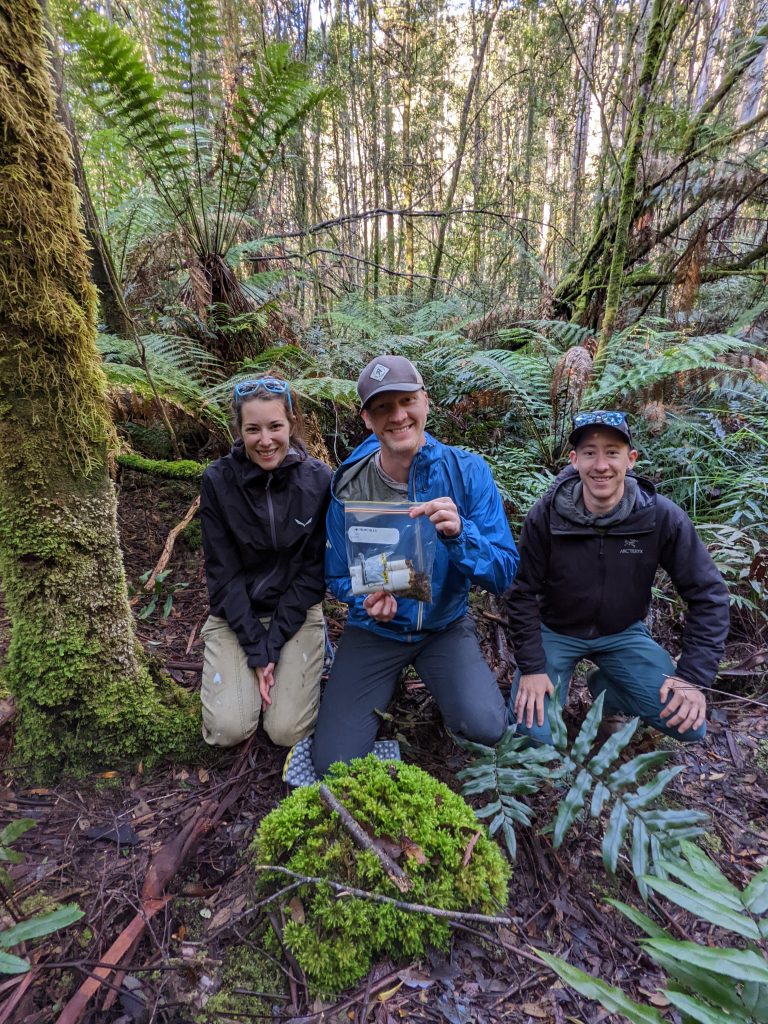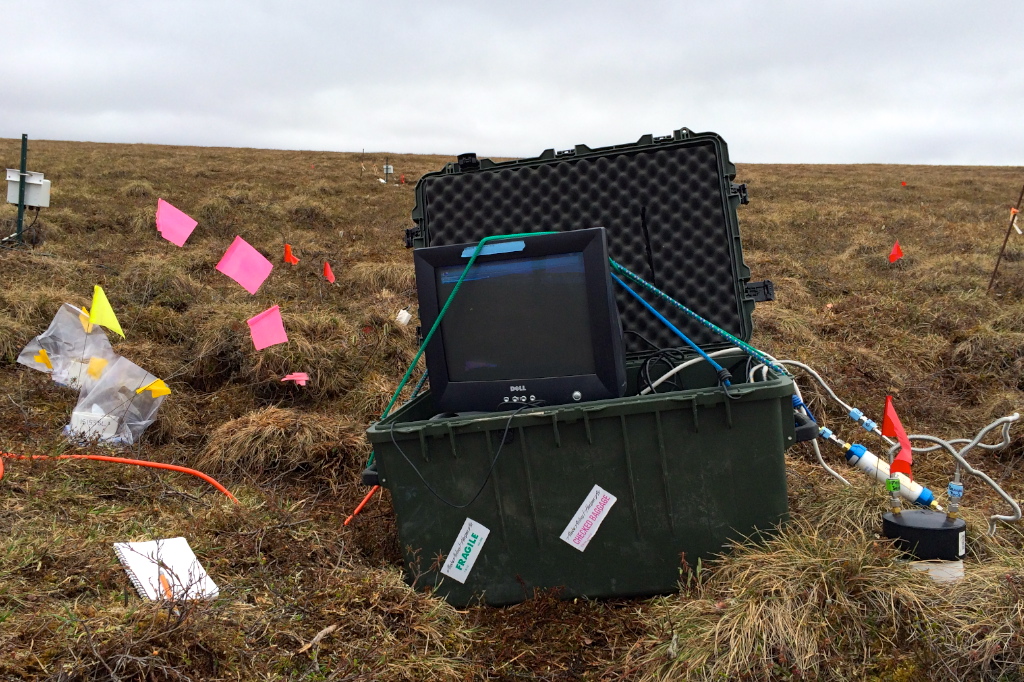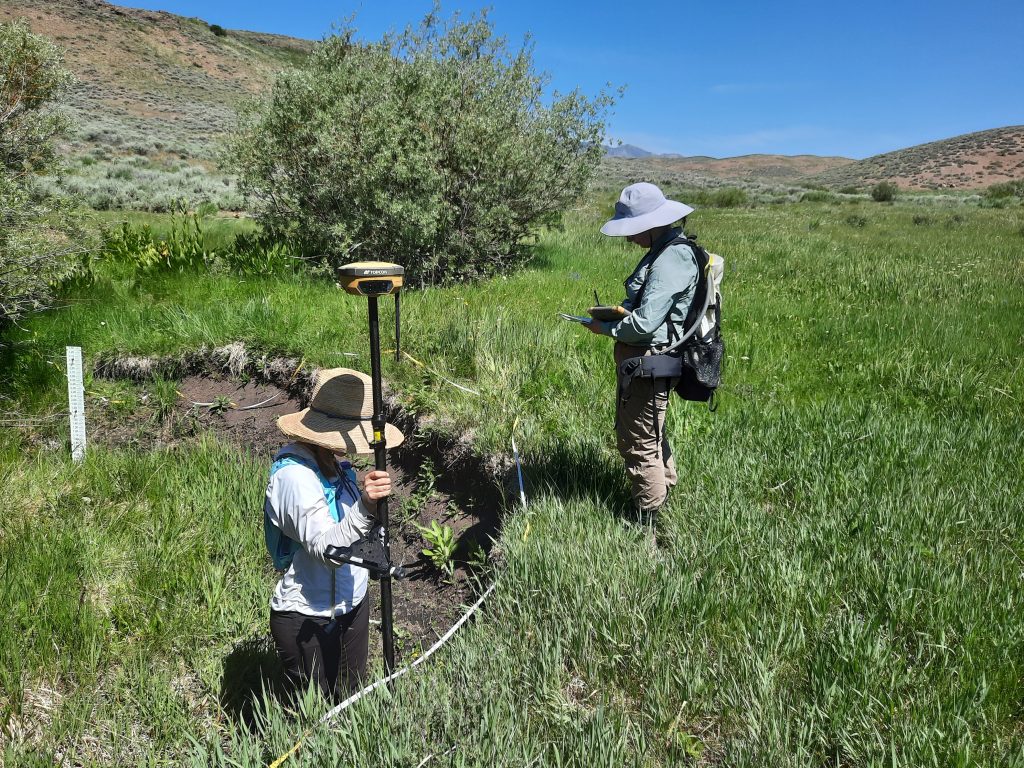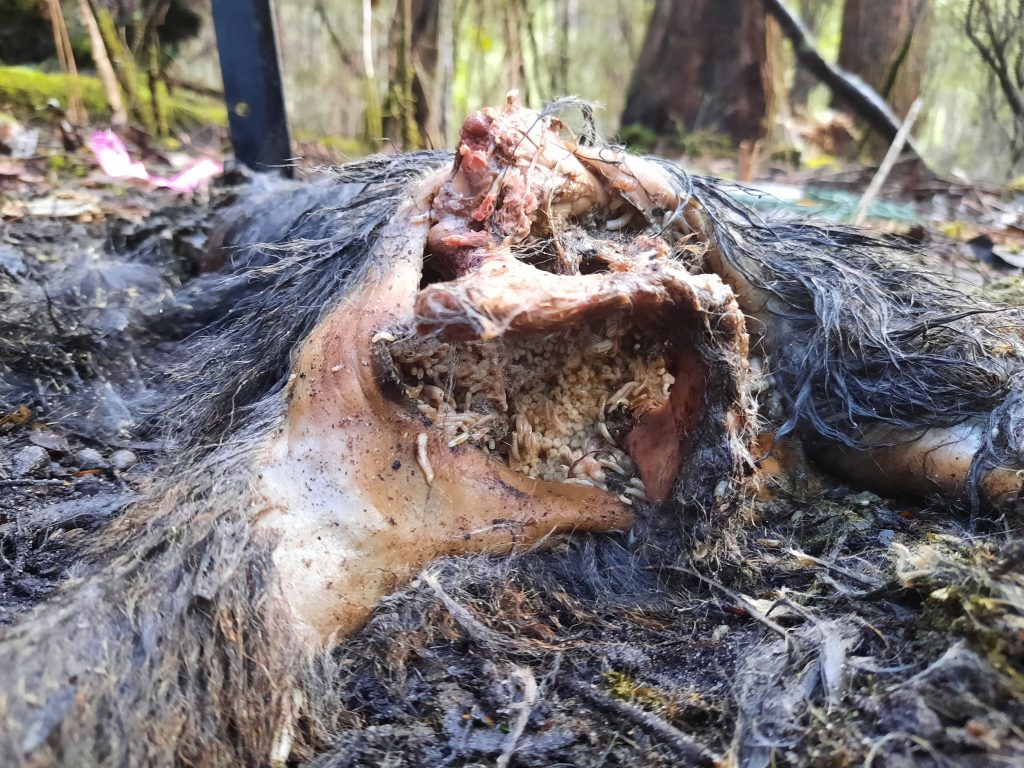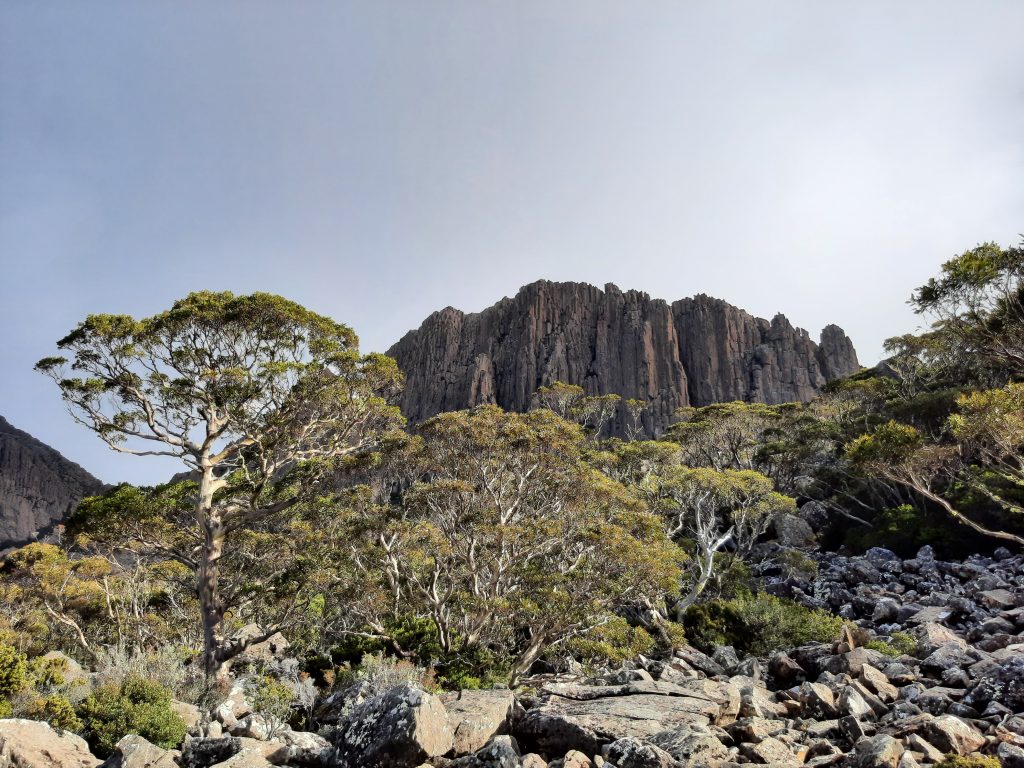A meal with the devil: how the eating habits of Tasmanian devils affect their ecosystems
In a healthy ecosystem, each microbe, plant and animal has its own important role to play. They may not be the most glamorous, but scavengers play a vital role in recycling nutrients back into an ecosystem. Dr Laurel Lynch, an ecosystem ecologist from the University of Idaho, USA, has been studying one particular scavenger, the Tasmanian devil, to better understand the impact they have on their ecosystems.
TALK LIKE AN ECOSYSTEM ECOLOGIST
Carrion — the decaying flesh of dead animals
Microbial community — a group of inter-related microorganisms, typically bacteria and fungi
Niche — the role that an organism plays in its ecosystem
Nutrient cycling — the process by which nutrients are transferred from living organisms into the non-living parts of an environment
Pitfall trap — a method to collect small animals, in which a hole is dug that animals then fall into. Typically, soil ecologists use pitfall traps to collect soil invertebrates, such as beetles, that also drive decomposition
Population gradient — the change in density of a population across an area
Scat — animal faeces
The next time you are in a forest, meadow or your local park, take a moment to pause and look around. Look closely. What do you see? Do you see bees bumbling lazily from flower to flower? Or pigeons collecting fallen sticks to construct their nests? What you will not see are the wispy tendrils of fungi that exchange nutrients with tree roots and the millions of microbes in the soil that break down dead matter.
Zoom out, and you might realise that you are looking at an intricate web of relationships in which every plant, animal and microbe are inter-related. Or, in other words, an ecosystem. Healthy ecosystems are incredibly complex. Within them, countless organisms are connected to each other and their surroundings, with each organism having its own niche to fill.
Scavengers, for example, play a vital role in ecosystems. They recycle nutrients back into the food chain by eating dead animals. As they digest their food, they convert organic matter into a form that other organisms can use to grow and generate energy. As a result, the carcasses of animals, called carrion, can create hotspots of biodiversity.
When microbes break down carrion, they deliver nutrients to the soil below that can be used by plants and other microbes. In contrast, when vertebrate scavengers eat a carcass, they redistribute nutrients throughout the ecosystem via their waste products. The decomposition of carrion is an integral part of healthy ecosystems, so studying this process helps researchers understand how animal behaviour affects ecosystems. Dr Laurel Lynch, from the University of Idaho, is studying Tasmanian devils and their scavenging behaviour to understand the role they play in their ecosystems.
What are Tasmanian devils?
Tasmanian devils are native to Tasmania, an island off the south-eastern coast of Australia. About the size of a small dog, these devilish creatures are the world’s largest carnivorous marsupial. “Since the extinction of the Tasmanian tiger, devils have occupied a unique niche, acting as the island’s top predator and scavenger,” explains Laurel. Devils’ activity has a direct impact on the behaviour of smaller scavengers like ravens, possums and feral cats. “Their activity may also impact other ecosystem processes, like plant productivity and soil nutrient cycling,” says Laurel.
Why are Tasmanian devils interesting to study?
“Devils are one of a few scavengers worldwide that are osteophages, or bone consumers,” says Laurel. “Skeletal material stores a lot of calcium and phosphorus, both of which are critical elements for plant and microbial growth.” Laurel is interested in whether devil scavenging accelerates the cycling of these nutrients from carrion into the soil, where they can drive microbial activity and plant growth.
In Tasmania, devil populations have been declining due to the spread of an infectious cancer called Devil Facial Tumour Disease (DFTD). DFTD spreads through social interactions and is nearly 100% fatal. As the disease has spread across the island, it has created a natural population gradient from the east, where devil numbers have declined dramatically, to the west, where some populations remain unscathed. Although this disease has tragic consequences, the population gradient provides an ideal opportunity to research devil behaviour and the impact it has on their natural habitat.
How is Laurel studying the devils?
Laurel and her team established four research sites that span the devil population gradient, from a site with no devils in the east, to a site with a thriving devil population in the north-west. By comparing results from these four sites, Laurel will be able to understand the impacts that devils have on their ecosystems.
At each site, Laurel set up three different experimental treatments: a staked carcass that could be accessed by all scavengers, a caged carcass that could be accessed by smaller scavengers but not devils, and devil scat latrines, or toilets, that allowed Laurel to determine what nutrients were being delivered from devil waste into the soil.
Once the carcasses were in place, Laurel and her team set to work collecting data. They deployed pitfall, aerial and camera traps to document the number, species and behaviours of different scavengers that visited the carcasses, and they took soil samples to test how nutrient availability and microbial communities were affected. They also collected leaf samples and tree cores, which record past climate and environmental stressors (like water and nutrient availability).
After collecting their data, Laurel and her team processed their samples in laboratories. They are currently analysing plant and soil samples, which will allow them to determine the concentrations of different nutrients, like carbon, nitrogen and phosphorous, at each of the treatment sites. In addition, by extracting DNA from soil samples, they will be able to discover how communities of bacteria and fungi were affected by the different treatments. By comparing these results to data from the camera traps, Laurel will determine the effects of Tasmanian devil scavenging behaviour.
What has Laurel discovered so far?
“Devils are extraordinarily effective scavengers,” says Laurel. “They can consume an entire carcass in one sitting!” In areas with lots of devils, the amount of nutrients being delivered directly into the soil is minimal, because carrion is removed so quickly. “However,” says Laurel, “indirect impacts of devil scavenging may be dispersed throughout the landscape through their scat.” To support this finding, Laurel is analysing soil samples from below the devil scat latrines to test for nutrients like calcium and phosphorous, which are plentiful in the bones that devils eat.
In contrast, carcasses in regions with fewer devils, as well as caged carcasses which excluded devils, were consumed more slowly. As a result, the carrion remained in the habitat for a longer time, allowing it to decompose and release its nutrients into the soil. As she analyses the soil from these treatment sites, Laurel expects the microbial communities will have transformed so as to take advantage of these high-quality resources.
Why is this research important?
Laurel’s research has combined the fields of population and community ecology, forest ecology, soil biogeochemistry and microbial ecology. Cross-discipline collaborations like this are vital to gaining a clear understanding of how complex ecosystems function. “Many ecosystem ecologists overlook animals, and many population and community ecologists overlook the ecosystem,” says Laurel. “But it is ultimately feedbacks and interactions among organisms and their environment that shape ecosystem function.”
Understanding these feedbacks is needed to make broader predictions about how ecosystems will respond to global climate change. As ecosystems experience the dramatic consequences of climate change, such as wildfires, droughts and floods, scientists and policymakers are realising that action must be taken to protect them. Cross-disciplinary collaborations such as Laurel’s will play an increasingly vital role in this process. The field of ecosystem ecology incorporates learning from many disciplines and is therefore well placed to help initiate these collaborations.
“Although carrion availability and decomposition might seem like a side story, it is one of the most crucial, yet understudied, processes in ecosystem ecology,” says Laurel. Lessons from Laurel’s research could be critical in reducing nutrient limitation in a warmer, drier world. Not only that, but it could provide a lesson to the whole scientific community on how collaborations are vital to advance science and protect our planet.
 Dr Laurel Lynch
Dr Laurel Lynch
Department of Soil and Water Systems, University of Idaho, USA
Fields of research: Ecosystem Ecology, Biogeochemistry
Research project: Investigating how the scavenging behaviour of Tasmanian devils affects nutrient cycling within their ecosystems
Funder: US National Science Foundation (NSF). This work was supported by NSF Award DEB-2054716.
Reference
https://doi.org/10.33424/FUTURUM359
ABOUT ECOSYSTEM ECOLOGY
Ecosystem ecology is the study of both the living and non-living parts of an ecosystem, and of how these parts interact. Laurel’s research focuses on how scavengers interact with their ecosystems, specifically looking at how nutrients from carrion are cycled back into soils, microbes and plants.
What other topics can ecosystem ecologists study?
Like Laurel, a lot of ecosystem ecologists focus on soils. Soils can draw carbon dioxide out of the atmosphere and store it underground. Understanding this process could have a significant impact on the world’s fight against climate change, so there is currently a lot of interest in this area. Other topics in ecosystem ecology include the cycling of organic molecules in rivers and streams, the role that forest fires play in nutrient cycling and habitat regeneration, and how food webs are influenced by environmental factors.
What does ecosystem ecology fieldwork involve?
There is a lot to do before fieldwork begins. “The most important order of business,” explains Laurel, “is identifying a compelling research question and designing a well-crafted experiment.” Then comes the planning, preparation and travel. “When we arrive, there is a flurry of activity as we perform final site selections, assemble equipment and deploy the experiments,” says Laurel. “From there, we’re off to the races!”
Sometimes data collection can be a quick process followed by months of lab work. Other times, the data collection can take months and involve lots of hard work in all kinds of weather conditions. “Data collection doesn’t stop just because the weather has turned or the sun has gone down,” says Laurel.
What are the most enjoyable parts of being an ecosystem ecologist?
The cross-disciplinary nature of ecosystem ecology makes for a lot of interesting conversations and collaborations. Learning from other disciplines is a great way for scientists to look at their own research with a fresh perspective. Ecosystem ecologists are often confronted with complex datasets that require careful analysis to uncover underlying patterns. “I have learnt to enjoy the challenges of analysing data,” says Laurel.
Pathway from school to ecosystem ecology
• As a scientist in any field, it is vital to develop strong written and oral communication skills.
• It is also important to build a strong foundation in the liberal arts, such as languages, literature, philosophy and history, to help you think critically about complex topics.
• Laurel recommends emailing professors at local universities to see if they have any volunteering opportunities you could participate in.
• At university, degrees in biology, ecology or environmental science could all lead to a career in ecosystem ecology.
• “Whether your journey through education is linear or not, reach out to colleagues and mentors, build up a network of people you enjoy collaborating with, and have fun exploring new ideas,” advises Laurel.
Explore careers in ecosystem ecology
• Work as an ecologist can vary dramatically from fieldwork in the wilderness, to analysing samples in a lab, or manipulating data and writing reports. A good sense of humour and genuine curiosity can be helpful when long hours in the field or lab start to build up.
• The Ecological Society of America provides information for students about what a career in ecology involves and what pathways you can take to get there: www.esa.org/programs/student-programs/info-for-undergraduate-students
• The University of Idaho (www.uidaho.edu/cals/soil-and-water-systems), where Laurel works, provides research opportunities for students and hosts events that can be attended in person or online. Most universities will offer similar opportunities.
Meet Laurel
What were your interests when you were growing up?
I began playing the violin when I was five, which helped me cultivate valuable skills in persistence and attention to detail. I now have a penchant for symphonies, chamber music and opera. I also loved camping and hiking in Alaska and Canada with my parents. I developed observational skills during these excursions that made me think about ecosystems for the first time: Why did some plants grow only on northern or southern exposures? What happened when permafrost was exposed to the atmosphere through deep thawing events? How could caribou herds survive on the barren tundra?
Who or what inspired you to become a scientist?
I was fortunate to have multiple wonderful mentors early in my career, including my AP biology teacher (Ms Beale!) and two research mentors in college who were biogeochemists and ecosystem ecologists (Dr John Schade and Dr Stephanie Quinn-Davidson). I was inspired by their research and commitment to developing robust undergraduate research experiences. Growing up in Alaska and going on big outdoor adventures with my family also inspired my fascination with ecosystem ecology, although I didn’t realise that until later in life.
What are your favourite fieldwork memories?
I have been lucky to work in many beautiful places around the world. As a summer research assistant, I got to explore long-term ecological research sites on my back door in Alaska, where I helped trap lynx and snowshoe hare. I also spent a summer living on a barge and working with my wonderful research mentor, Dr John Schade, to design and test ecological theory in small Siberian streams underlain by ancient permafrost. As a PhD student, I spent multiple summers working in tundra ecosystems in Alaska. The fieldwork was extremely challenging. We often spent 20+ hours at our field sites battling hordes of mosquitoes and unexpected snowstorms. At the end of our field experiments, we excavated hundreds of pounds of freezing soil by hand and shipped them back to our labs at Colorado State University, where we spent months in the lab conducting incubation experiments and preparing samples for detailed instrumental analysis. The camaraderie of great colleagues, brainstorming ‘novel ideas’, and pursuit of scientific knowledge is inspiring and contagious.
What are your ambitions for the future?
My long-term goals are to continue learning about new systems, integrating new fields, and challenging myself intellectually. I’d like to follow in the footsteps of my postdoctoral mentor, Dr Johannes Lehmann, who challenges himself to reinvent his lab every five years.
What do you enjoy doing when you are not working?
I love reading for fun, travelling, and exploring nature through mountain biking, skiing, and rock-climbing adventures.
Laurel’s top tips
1. Seek out high school and undergraduate research opportunities.
2. Read broadly and deeply to uncover gaps in scientific knowledge.
3. Collaboration is important and is vital to conducting good research.
Do you have a question for Laurel?
Write it in the comments box below and Laurel will get back to you. (Remember, researchers are very busy people, so you may have to wait a few days.)


